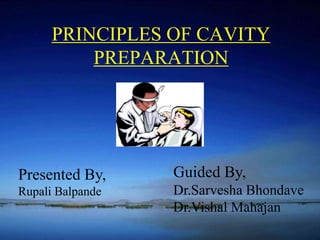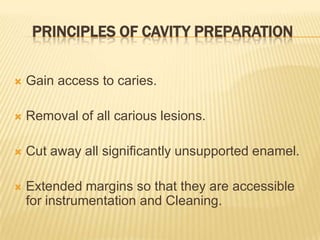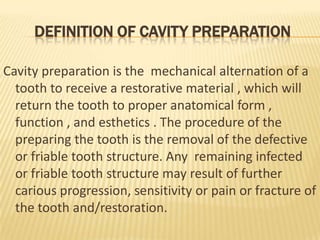Remove defects and provide protection to pulp. Study principles of cavity preparation.

Principles Of Cavity Preparation By Dr Rupali
Flashcards from Caitlin Jenkinss Dundee university class online or in Brainscapes iPhone or Android app.

. While other techniques for cavity preparation were developed by the industry over the years such as air-abrasion and laser their use however never gained popularity due to their inherent limitations. Allow for the esthetic and functional placement of a restorative material. Form the cavity so that under the forces of mastication the tooth or the restoration will not be displaced.
The dentist may use burs diamond stones or hand-cutting instruments chisels hoes hatchets and gingival margin trimmers to complete the walls by removing loose or unsupported enamel to. Done by Carla Malaeb Mariam Masri Zakaria Mazloum Alaa Mourad Mohammad Moukhader 6-Toilet of the Cavity Toileting Technique. An operation in which carious material is removed from teeth and biomechanically correct forms are established in the teeth.
Complete Caries removal and preventing the. Learn faster with spaced repetition. DEFINITION OF CAVITY PREPARATION Cavity preparation is the mechanical alternation of a tooth to receive a restorative material which will return the tooth to proper anatomical form function and esthetics.
During Cavity preparation the pulp tissue must be protected against the frictional mechanical or. Biological Principles of Tooth or Cavity Preparation Protection of Pulp. Increase resistance to fracture.
1-Establishing outline form 2-Obtaining resistance form 3- Obtaining retention form 4- Obtaining convenience form 5- Removing remaining caries 6- Finishing cavity walls and margins 7- Performing toilet of the cavity. Bouchers Clinical Dental Terminology. CAVITY PREPARATION a surgical procedure that removes caries and excises the tooth tissue in order to develop the mortise form that will support and retain the restorative material the orderly operating procedure required to establish in a tooth the biomechanically acceptable form necessary to receive and retain a restoration 3.
1-Phenol Pulp necrosis 2-Silver 3-Alcohol 4-Hot air blast 5-Hydrogen peroxide 6-Water spray FOR WHAT REASONS WE DO THE TOILETING. The orderly operating procedure required to remove diseased tissue and establish in a tooth the biomechanically acceptable form necessary to receive and retain a restoration. Aims of Tooth Preparation.
Definition of Cavity Preparation. 1removing any remaining enamel within prep diseased dentin or old restorative material. Friction between the restorative material and the walls of the cavity preparation acts to retain all types of restoration.
1-The outline form It is defined as Shape of the boundaries of the completed cavity External outline form refers to the marginal boundaries Internal outline form refers to the shape. Allow esthetic and functional placement of material. This is a process of angling beveling and smoothing the walls of the cavity preparation to achieve the best marginal seal possible between the restorative material and tooth structure.
Terms in this set 41 Dental Caries. Definition of Cavity preparation The mechanical alteration of a defective injured or diseased tooth in order to best receive a restorative material which will re-establish a healthy state for the tooth including esthetic corrections where. Cavity preparation is the process of removing diseased tooth structure while leaving a limited amount of healthy tooth structure for the tooth to maintain a restoration.
The procedure of the preparing the tooth is the removal of the defective or friable tooth structure. Can also cause such defectsCavity preparation. The main principles of cavity preparation are to preserve the underlying tooth structure protect the pulp tissue save as much as Enamel or Dentin as possible shape the cavity to achieve maximum resistance and Retention as possible depending on the type of restoration used to help in bearing the mastication forces.
Frictional retention is improved by increasing the area of the walls cavity depth and making opposing walls parallel proper box form 37. It is defined as the mechanical and surgical alteration of a defective injured or diseased tooth in order to best receive. Proper cavity preparation is accomplished through systematic procedures based on definite physical and mechanical principles.
Locate the margins of the restoration as conservatively 3. Final preparation in cavity preparation. Principles of Cavity Preparation.
Prevent Recurrence of Caries. When cavity preparation is complete cavities are rinsed with water and cleaned of any remaining debris in preparation for the restoration. The degradative pathologic process which causes a defect cavity in enamel or enamel and dentin of a tooth.
Steps of cavity preparation 1- Outline form 2- Resistance and Retention form 3- Convenience Form 4- Removal of remaining Caries 5- Finishing of cavity walls 6- Toilet of the cavity 13. 2inserting addition resistance like notches grooves to provide strength. Other processes such as abrasion erosion etc.
Objectives of cavity Preparation. 3placing protective dental materials such as. The principles of cavity preparation are divided into two stages each with several steps.
Retention form is achieved through. Caries is a disease which attacks the tooth. Definition of cavityIs defined as a defect in enamel dentin or cementum resulting from the pathological processes mostly the dental caries.
Remove all defects and give the necessary protection to the pulp.


0 Comments